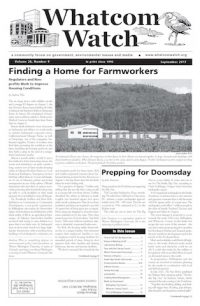by Al Hanners
To celebrate 26 years of publishing Whatcom Watch, we are printing excerpts from 20 years ago. The below excerpts are from the September 1997 issue of Whatcom Watch.
Editor’s Note: The city of Bellingham published 28 issues of a periodical entitled “Your City” between April 1997 and Spring 2002.
The article on Bellingham’s water quality that appeared in the August 1997 issue of the city newsletter reminds me of a story that made the rounds years ago when I worked on the 29th floor of the Chrysler Building in New York City. It was one of the early skyscrapers built in the 1920s where office workers could and did open the windows. One day a man sat looking out an open window when he saw a man falling past. He called out, “How are you doing?” “All right so far,” was the reply.
Like the falling man, the city newsletter article showed almost no vision of the future. Someone in city government, and it is not clear who, wants us to believe that the city is doing a great job of ensuring Bellingham water quality. Comments by Chris Spens are an exception. Even he did not mention the D-word, development, the nemesis that will destroy Lake Whatcom water quality in the future.
The same August newsletter (page 2, question 1) also provides a handy how-to-do kit for acceleration of the destruction of Lake Whatcom water quality by those who live in the watershed. Just double the density of population zoned for single families in the city portion of the watershed. Build accessory dwelling units called ADUs, in essence, duplexes.
Bellingham voters should take immediate action to protect future water quality and, therefore, their pocketbooks by rejecting accessory dwelling units in the city portion of the Lake Whatcom watershed. They should make their influence felt by attending the City Council meeting on September 22, (the [August 18] date in the city newsletter is a mistake), or by submitting written testimony.
In fairness to city employees and elected Bellingham officials alike, I must point out that the city government is not monolithic. Many of them fully understand the issues and are very concerned about the future of Bellingham’s water supply. Nevertheless, to city government and in our local press, it is almost as if there is a conspiracy of silence. The gut issues are not discussed. That is the reason I wrote this article for publication in Whatcom Watch.
The quality of Bellingham’s future water supply from Lake Whatcom is beset by several interrelated problems, chiefly pollutants, politics, and greed. Unlike the watersheds of cities such as Seattle that are protected from residential, commercial, and industrial development, much of the Lake Whatcom watershed already is developed and, moreover, is under tremendous pressure for further explosive expansion of housing developments that would complete the degradation of water quality.
Phosphate is the smoking gun that ties development to deterioration of water in Lake Whatcom. For technical details see my following article. While Bellingham water users are saddled with water treatment costs, the practice of treating the major portion of the Lake Whatcom watershed outside of Bellingham as a cash cow by the county is a serious political threat to Bellingham residents. The county passed regulations for accessory dwelling units doubling the allowable residential development in the entire county with no exception for the Lake Whatcom watershed. Moreover, when quite a few lots in Sudden Valley went back to the county for non-payment of taxes, the county resold them for residential development. It should have held them off the market or sold them only to holders of adjacent lots while prohibiting additional development.
The Growth Management Act, the Whatcom County Comprehensive Plan, and the Council of Governments, in no way effectively treat the water quality issue. Because Bellingham is stuck with the bulk of water treatment costs, county politicians who understand and are concerned simply will not address the issue. In a legal sense, the water quality is the reverse of the criminal justice system controversy that festered for years. Bellingham freeloaded on the county until the county sued the city. People are people, especially politicians struggling under constraints of tight budgets. So too, we can expect the county to continue to freeload on Bellingham by developments that increase water treatment costs borne by the city. The county will continue until Bellingham voters fully understand that their pocketbooks are being hurt. We can hope that they will elect City Council members on November 4th who will put teeth into continued enforcement of the contract between Water District #10 [now the Lake Whatcom Water and Sewer District] and the city and use it as a tool to control Lake Whatcom water quality.
________________________________________
At the time this article was written, Al Hanners was a retired geologist. In 2002 Al Hanners was honored as Watcher of the Year: http://www.whatcomwatch.org/php/WW_open.php?id=207




























